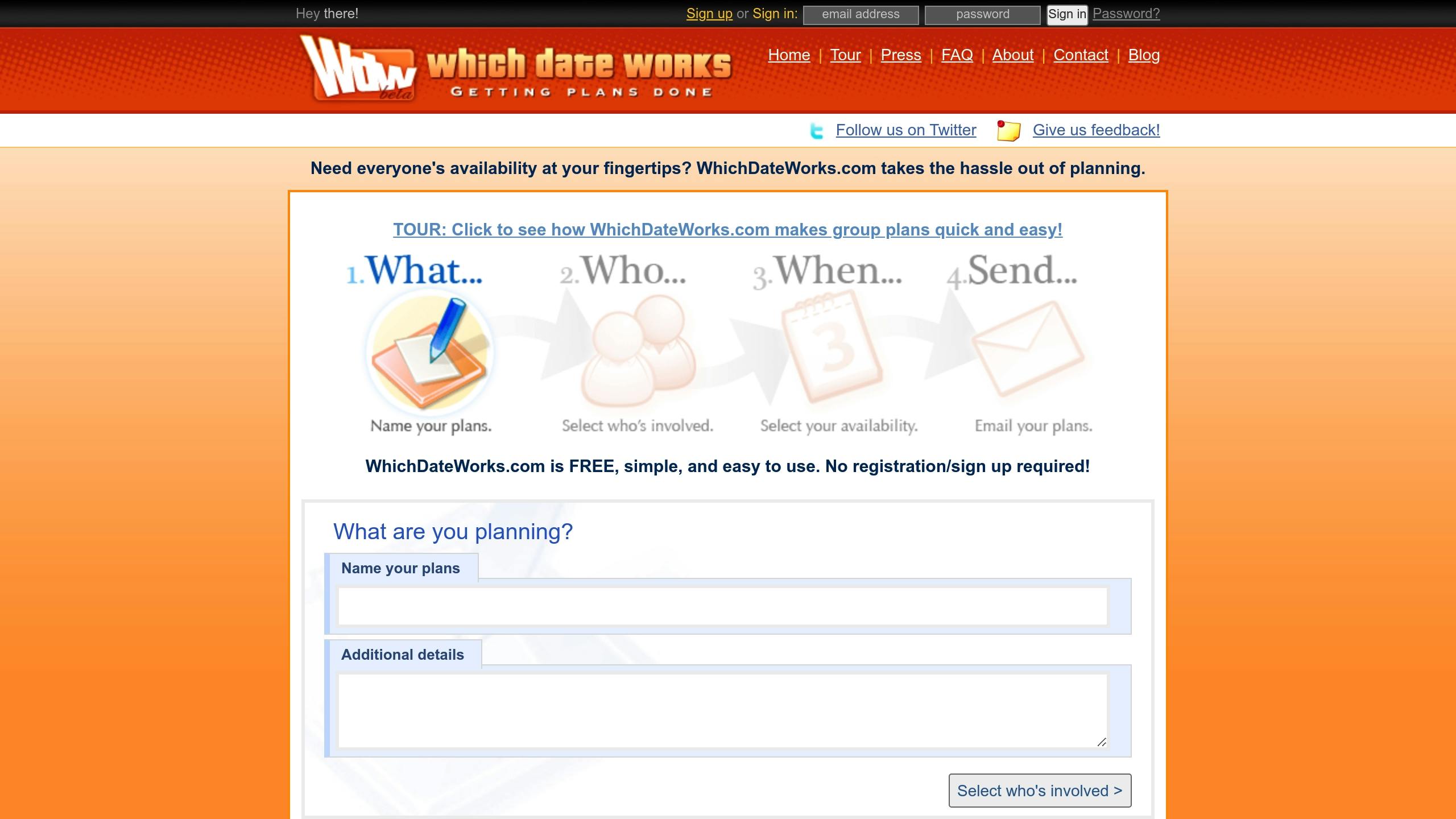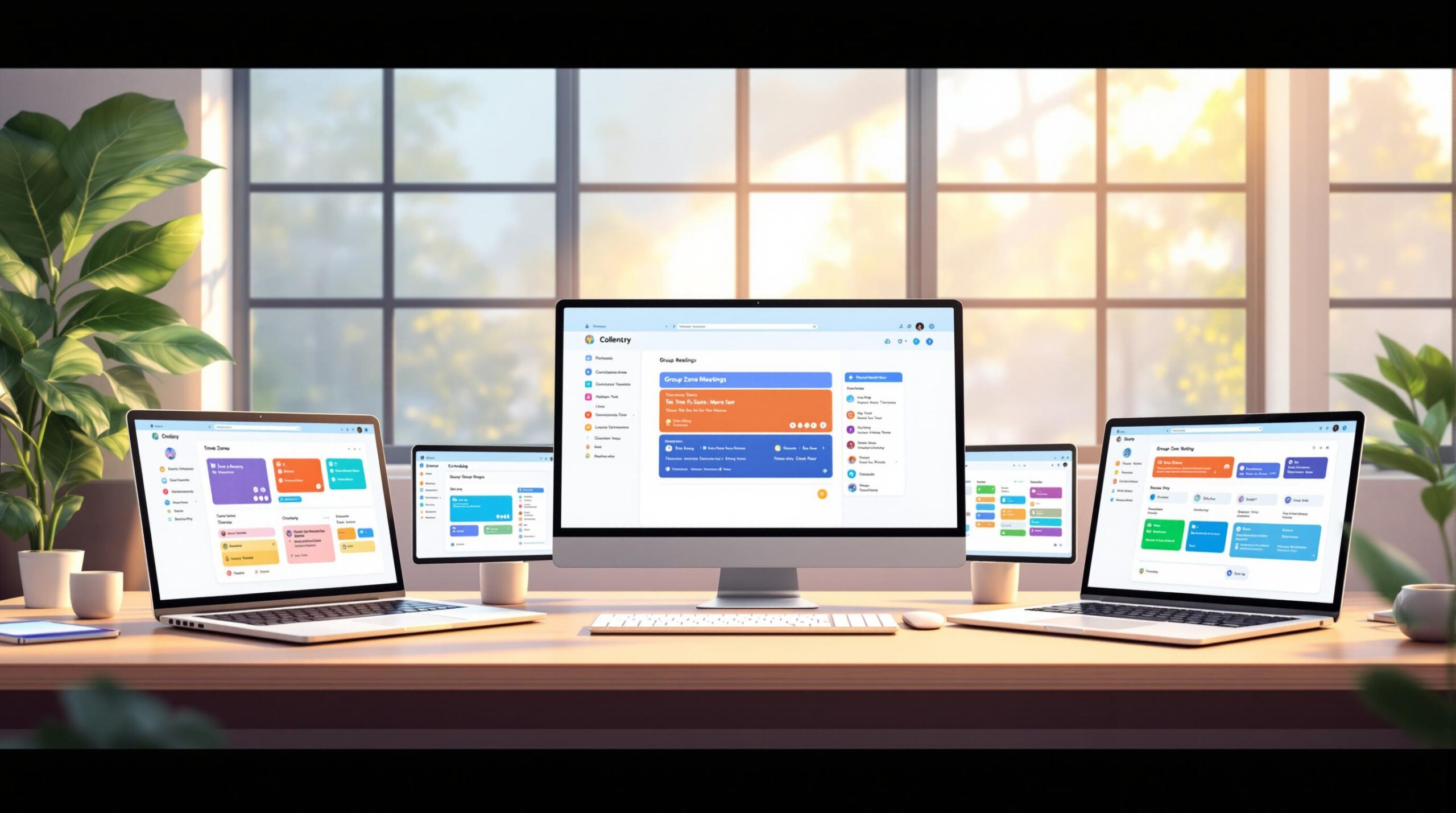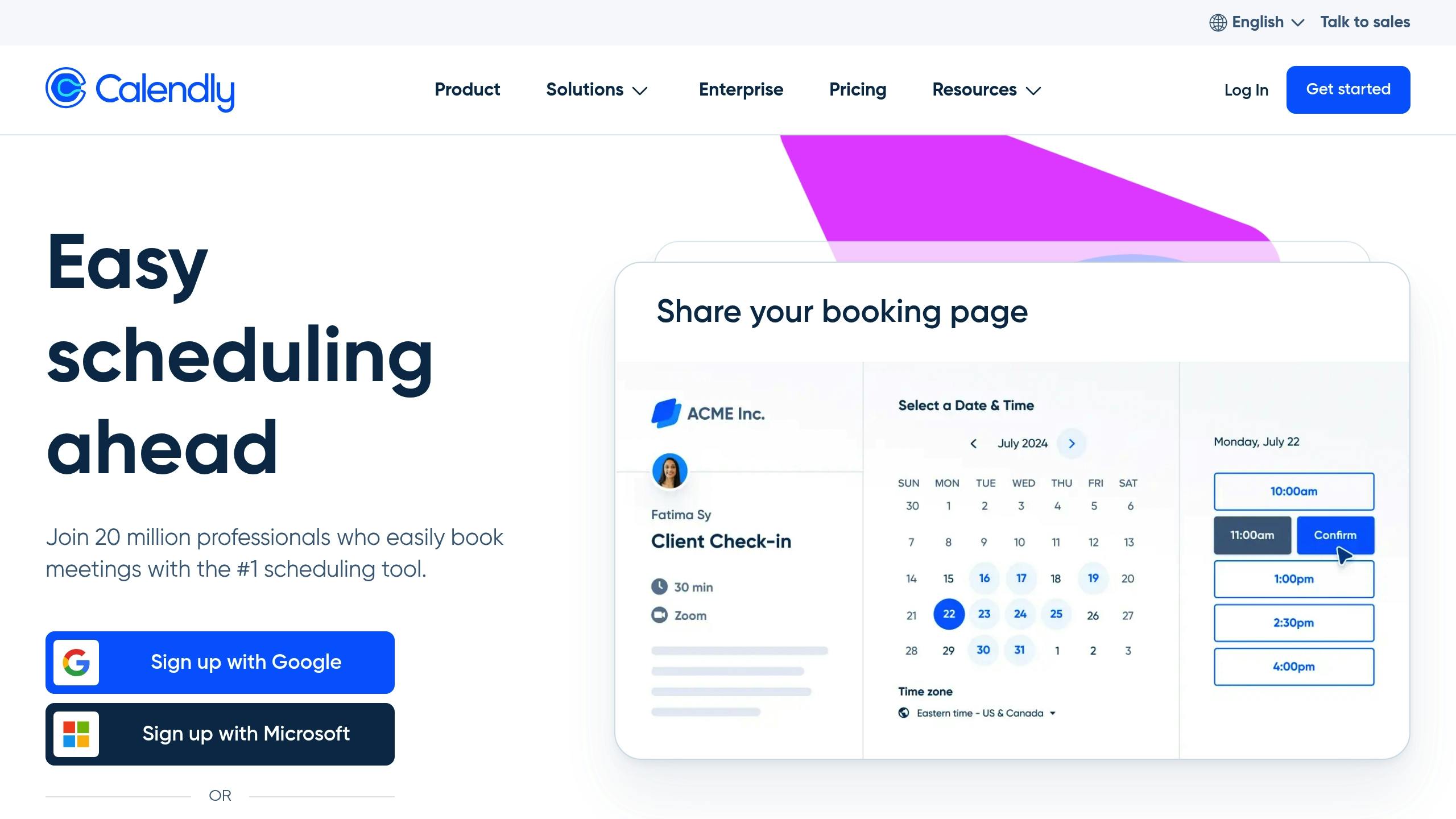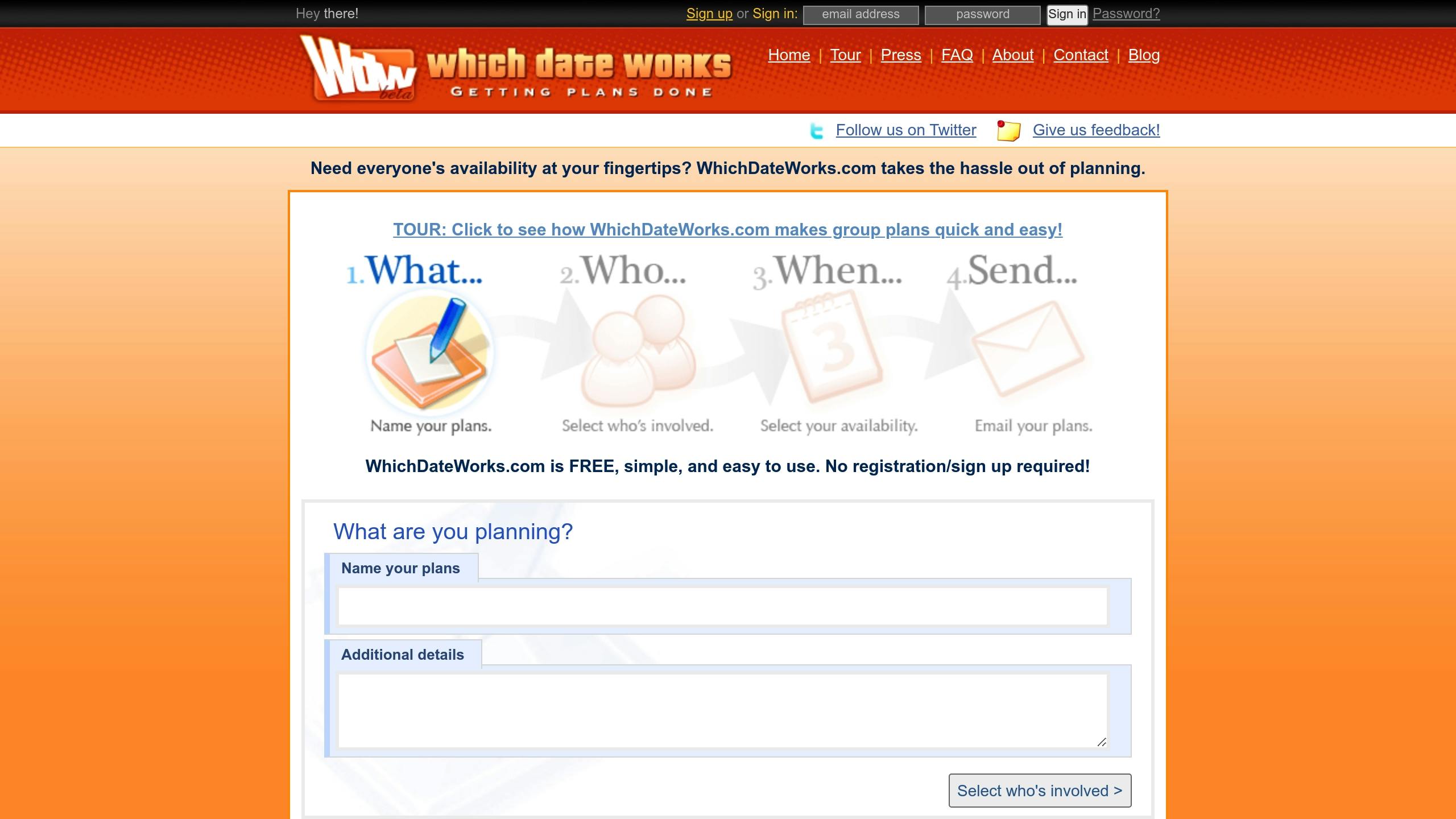Finding the best date for a group event can be tough, but it’s crucial for maximizing attendance and avoiding scheduling headaches. Here’s how to make it easier:
- Start with the Basics: Define event details like duration, venue, budget, and key attendees.
- Use Scheduling Tools: Platforms like Doodle, When2Meet, and WhichDateWorks can simplify date selection.
- Handle Time Zones: Use tools like Calendly to adjust for global participants and rotate meeting times for fairness.
- Prioritize Attendees: Focus on scheduling around essential participants and provide alternatives for those who can’t attend.
- Lock in the Date: Share 2-3 options, gather feedback, and finalize the date well in advance to boost attendance.
Quick Comparison of Scheduling Tools
| Tool | Best For | Features | Drawbacks |
|---|---|---|---|
| Doodle | Business meetings | Calendar sync, custom polls | Limited features in free plan |
| When2Meet | Casual meetups | Real-time availability grid | Simplistic design |
| WhichDateWorks | Informal group planning | No registration, easy sharing | Lacks advanced analytics |
With proper planning, the right tools, and clear communication, you can choose a date that works for everyone and ensures a successful event.
How to Easily Schedule Group Meetings
Step 1: Set Your Event Basics
Before jumping into scheduling tools or checking availability, it’s crucial to nail down the key details of your event. Having these basics in place makes it much easier to choose a date that works for everyone. Plus, it helps ensure your event runs smoothly and hits its attendance goals.
Define Event Essentials
Start by identifying the non-negotiable details:
- Event Duration: Outline the start and end times, including setup and cleanup.
- Venue Needs: Think about space requirements, AV equipment, and catering options.
- Budget Limits: Consider how seasonal pricing might impact venue costs.
- Timing Preferences: Highlight blackout dates and preferred timeframes.
Identify Key Attendees
Break down your participants into three groups:
- Essential Participants: These are the must-haves, like key stakeholders or presenters.
- Important Contributors: Team leads or subject matter experts who play a big role.
- General Attendees: Those whose attendance is optional or more flexible.
Using the RACI model (a common project management tool) can help you organize these groups effectively. Start by confirming availability for VIPs and key stakeholders to narrow down potential dates. Don’t forget to factor in time zones, which can complicate scheduling – a topic we’ll dive deeper into in Step 3. This prioritization will be critical when resolving scheduling conflicts later.
Step 2: Use Online Scheduling Tools
Once you’ve nailed down the basics of your event, it’s time to make scheduling easier with online tools. These platforms can save you a ton of time and effort when coordinating dates for group events.
Comparing Popular Scheduling Tools
The best tool for your event depends on factors like group size and the type of gathering. Here’s a quick breakdown of some popular options:
| Tool | Ideal For | Features | Drawbacks |
|---|---|---|---|
| Doodle | Business meetings, small to medium groups | Syncs with calendars, custom polls | Free version has limited features |
| When2Meet | Casual meetups | Real-time availability grid | Simplistic design |
| WhichDateWorks | Informal group planning | No registration needed, easy sharing | Lacks advanced analytics |
Doodle is a go-to choice for professional events, with over 30 million users every month. Its polished interface and calendar syncing make it perfect for business scenarios.
When2Meet is great for casual get-togethers, managing over 100,000 polls daily.
WhichDateWorks keeps things simple, offering easy scheduling without requiring users to sign up – ideal for informal plans.
Tips for Using Scheduling Tools Effectively
To get the most out of these tools, consider these tips:
Set Clear Guidelines
Include any must-have details, like time limits or specific requirements, to avoid confusion.
Encourage Quick Responses
Set a deadline for replies and use automated reminders to nudge participants.
Leverage Calendar Syncing
Tools like Doodle can automatically check for scheduling conflicts, saving you from back-and-forth emails.
Combine Reminders with Personal Outreach
If someone still hasn’t responded, a quick personal message can go a long way.
Once you’ve narrowed down potential dates, you’ll be ready to tackle the next challenge: handling time zone differences and accommodating key attendees. These tools are just the first step in making your event planning smooth and efficient.
sbb-itb-e90075f
Step 3: Fix Schedule Conflicts
Manage Time Zones
If you’re working with a global group, time zones can be tricky. Here’s how to handle them effectively:
Use Tools That Account for Time Zones
Scheduling platforms like Calendly automatically adjust for time zones and show meeting times in each participant’s local time. This reduces confusion and helps avoid missed meetings.
Group Participants by Region
For events that need live interaction, grouping attendees by region can simplify scheduling. This approach is often used in corporate training sessions.
Rotate Meeting Times
For recurring events, rotating the schedule across time zones can help balance accessibility:
- Week 1: Times that suit the Americas
- Week 2: Times that suit Europe
- Week 3: Times that suit the Asia-Pacific region
Once you’ve handled time zone challenges, it’s time to tackle participant availability conflicts.
Set Attendance Priorities
Sometimes, scheduling conflicts are unavoidable. Here’s how to manage them:
Focus on Key Attendees
Use the categories from Step 1 (Essential, Important, and General attendees). First, prioritize scheduling around Essential participants. Then, try to accommodate Important contributors if possible.
Provide Alternatives for Those Who Can’t Attend
When key stakeholders can’t make it, offer options like:
- Pre-event briefings or access to recorded sessions
- Follow-up meetings to discuss key points
- Written summaries to keep them in the loop
Hybrid event formats can also help ensure everyone stays connected, even if they can’t attend live.
With these strategies in place, you’re ready to finalize the event date.
Step 4: Lock In the Date
Get Everyone on the Same Page
Now that conflicts are resolved and priorities are clear, it’s time to finalize the date. Here’s how to do it:
- Pick 2-3 possible dates based on the data you’ve gathered and share the availability patterns with the group.
- Set a deadline for feedback: Give participants 48-72 hours to flag any major conflicts before the date is locked in.
Data shows events announced at least 6 weeks ahead tend to have 27% higher attendance compared to those announced less than 4 weeks in advance. Timing matters!
Announce the Date
Once the date is set, make sure to communicate it clearly and effectively.
Best Channels to Use
| Channel | Purpose | Key Details |
|---|---|---|
| Calendar Invites | Official scheduling | Auto time-zone adjustments, location |
| Detailed info | Purpose, prep needs, RSVP deadline | |
| Group Messages | Quick updates | Brief reminders, links to details |
What to Include in Your Announcement
- The final date and time (with time zones)
- Venue or platform details
- RSVP deadline
- Contact info for questions
To keep everyone on track, consider automating reminders. This approach ensures consistent follow-ups and keeps communication smooth for all participants.
Conclusion: Key Steps to Success
By blending thoughtful planning with modern scheduling tools and effective conflict resolution, organizers can turn scheduling headaches into smooth processes. The four-step approach – from defining needs to locking in dates – provides a clear way to streamline efforts while ensuring everyone’s needs are considered.
Key Elements for Effective Scheduling
Getting scheduling right means focusing on three main areas: clear priorities, using the right tools, and resolving conflicts effectively. For example, tools like Doodle can simplify coordination, helping organizers stay on track without losing sight of creating a great event.
The Role of Technology
When combined with clear planning, digital tools allow organizers to spend less time on logistics and more on delivering a great experience. Striking the right balance between automation and personal communication ensures everything runs smoothly.
After choosing a date, keep things moving by:
- Setting firm deadlines for responses to speed up decisions
- Including virtual options for those with conflicts
- Gathering feedback from attendees to improve future planning
FAQs
How to find a date that works for a group of people?
Coordinating a date for a group can be easier with the right tools and strategies. Start by considering your group’s size and needs, and choose a scheduling tool that aligns with those priorities.
Here’s how to approach it based on group size:
For Small Groups (5-15 people)
- Use quick polls to gather availability.
- Prioritize tools that provide fast response times.
For Medium Groups (16-50 people)
- Choose tools with calendar integration features.
- Set clear deadlines for responses to keep things organized.
For Large Groups (50+ people)
- Opt for advanced platforms that can handle bigger groups.
- Offer multiple session options to accommodate more participants.
Helpful Tips:
- Pick tools that automatically adjust for time zones.
- For global groups, tools like World Time Buddy can be a lifesaver.
Modern scheduling tools can even analyze calendar patterns to recommend the best times, making the whole process smoother and more efficient.















